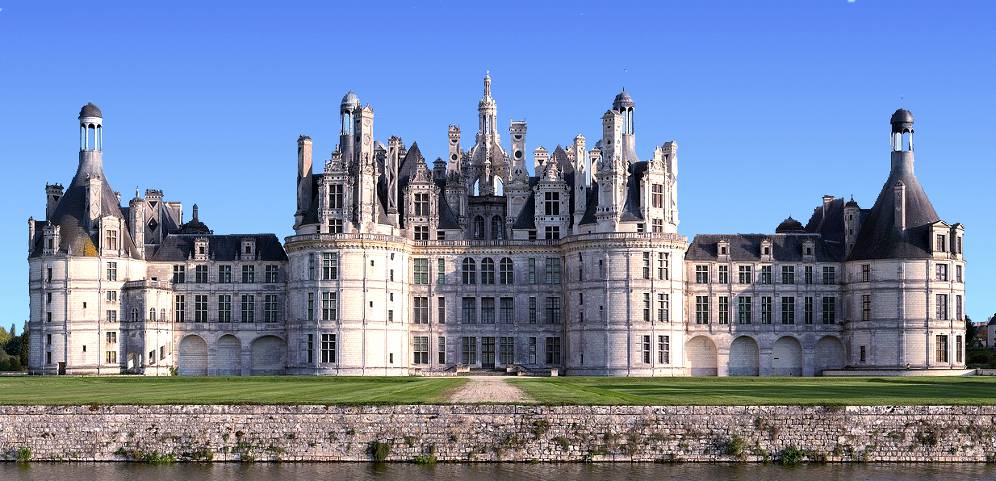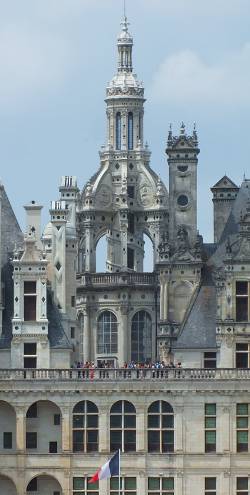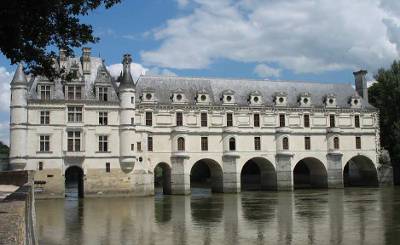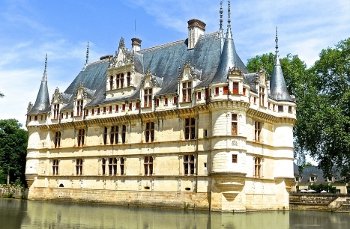
The greatest châteaux of the Loire
The Loire châteaux and their history
- Explore France ►
- Essential pages
- Travel in France
- Where to go
- What to see and do
About-France.com
- the connoisseur's guide to France
COVID info:
France is fully open for tourism.
Visitors no longer need to show a valid Covid vaccination
pass
to gain entry to sites. The wearing of
facemasks
remains recommended or obligatory in certain enclosed
locations. For
up-to-date details on remaining covid restrictions in France,
see
Covid passes.
Click on markers to show the name and a thumbnail image of any chateau
 Mediaeval
châteaux;
Mediaeval
châteaux;  Renaissance
châteaux;
Renaissance
châteaux;  Later
châteaux
Later
châteauxThe Châteaux of the Loire in history
Find
hotels in the Loire valley

Click
for best
online rates for hotels near the cities of the Loire valley
Loire
valley
Orleans
Blois
Amboise
Tours
Chinon
Angers
Saumur
Chartres
Bourges
Paris
Other areas
At the end of
the Middle Ages, France changed. The Medieval
period had been a time of wars and conflicts when France was rather
smaller than it is today. Areas of France had been fought over, notably
between the French and the English (who were still French at the time),
the French and the Burgundians, and other powers to the south and the
east. Medieval castles needed to be fortresses, defensive positions in
strategic locations, or bastions built to affirm the power of a local
duke or baron. The massive royal fortress at Angers
is a fine
example of this.
Orleans
Blois
Amboise
Tours
Chinon
Angers
Saumur
Chartres
Bourges
Paris
Other areas
About-France.com
is
partnered with Europe's leading hotel booking portal, Booking.com, to
bring you the best online prices
In the year 1475, the Hundred Years' War with England came officially to an end. Two years later, on the death of Duke Charles the Bold at the battle of Nancy, King Louis XI took over Burgundy and Picardy, and reestablished the power of the King of France over most of the area we know of today as France. An era of relative peace was ushered in.
This coincided with the arrival in France of the Renaissance, an artistic and cultural movement that had begun in Italy a hundred years before; and as the ideas of medieval and feudal society died out, dukes, princes and kings began to convert old castles, and build new ones, that were not designed for war, but designed for peace. The 16th century châteaux, for which the Loire is justly famous, were built as Renaissance palaces where their owners could enjoy the good life and partake in their favourite sports, notably hunting in the forests of the Loire valley.
The first of the Renaissance Loire Chateaux is said to be the Ducal Palace at Nevers (Burgundy), built between 1470 and 1490 to replace an earlier fortified castle; but the building of the greatest Loire chateaux took place between 1490 and 1550. The most intense period of activity was during the 20 years between 1514 and 1534; the Chateau de Chenonceau was started in 1514, a year before King François 1 began renovating the château de Blois. The château at Azay-le-Rideau was started in 1518, the château de Chambord in the following year 1519, and the château de Valançay the year after. The château de Villandry was begun 12 years after that. More châteaux were built, or rebuilt, over the ensuing century, giving the Loire valley area an exceptional heritage of Renaissance palaces, recognised today as a UNESCO world heritage site.
| Château | Department | Brief description |
|---|---|---|

Medieval castles in the Loire valley |
||
| Angers | Maine et Loire | One of the greatest medieval fortresses in the west of France, located in the middle of the city of Anger, on the river Maine, a tributary of the Loire. (► tickets ) |
| Chinon | Indre et Loire | On the banks of the river Vienne, the Royal Fortress at Chinon was a royal residence in the 12th century. King Henry II of England died here in 1189. Joan of Arc stayed here in 1429. The fortified medieval castle stands on a rock dominating the small town of Chinon . (► tickets ) |
| Amboise | Indre et Loire | The château at Amboise was a fortified royal stronghold on the Loire, and its ramparts remain impressive to this day. Inside the ramparts, king Charles VIII ordered the building of a new royal palace in 1490, which was subsequently modified in the Italianate Renaissance style. Leonardo da Vinci came here in 1515, spent the last years of his life here, and was buried here. (► tickets ) |
| Sully sur Loire | Loiret | Lying southeast of Orleans, away from the main cluster of Loire châteaux, Sully is an impressive medieval castle that was adapted for more peaceful use in the sixteenth century. It stands in its moat in what is actually an oxbow lake of the river Loire. It once stood guard over one of the points where the Loire could be forded in times of low water. |

Early Renaissance châteaux |
||
| Nevers | Nièvre | Reputedly the first of the Renaissance Loire châteaux, this is quite a bit further down the Loire valley, at the western edge of the region of Burgundy |
| Langeais | Indre et Loire | Historic medieval castle that was converted into a Renaissance château in the early fifteenth century. The Renaissance château still has some features more common to medieval castles. |
| Blois | Loir et Cher | A historic royal castle, the Château which stands in the small town of Blois existed well before the Renaissance. The château contains one of the finest medieval gothic halls in France. In the early 16th Century, King François I added a new wing, the Renaissance wing, which is one of the finest pieces of Renaissance architecture in France. (► tickets ) |

Renaissance châteaux |
||
| Azay le Rideau | Indre et Loire | A château that is very much on the tourist trail, Azay le Rideau stands on an arm of the river Indre which serves it as a moat. (► tickets ) |
| Chenonceau | Indre et Loire | Very visited, Chenonceau is no doubt the most romantic of the Loire Chateaux, standing as it does litterally on the river Cher (► tickets ) |
| Chambord | Loire et Cher | The iconic French chateau, Chambord is also the biggest and (being also the nearest to Paris) the most visited of the Loire châteaux. Designed as a hunting lodge for King François 1st (François Premier), The castle is surrounded by a purely decorative moat. It was designed in the Italian Renaissance style by Domenico da Cortona, and it is said that Leonardo da Vinci may have had a hand in the design too, while he was living at Amboise. (► tickets ) |
| Ussé | Indre et Loire | The chateau that stands today was started in the 1540s; it was later extended and embellished in the 16th and 17th centuries, to give it the picturesque romantic aspect it has today. |
| Valançay | Indre | Building started in 1540. The Renaissance chateau was extended in the 17th century. |
| Villandry | Indre et Loire | Alongside a 12th century keep, Jean le Breton, a minister of king François I, built the last of the great Renaissance Loire châteaux, which was completed in 1536. (► tickets ) |

Later châteaux |
||
| Cheverny | Loire et Cher | Another very visited château, Cheverny was actually built in the 1630s, a hundred years after the great period of Renaissance castle building in the Loire valley. Though similar in many ways to the great Renaissance castles, it is built in the seventeenth century classical style. |
. France : there's so much more to discover......
- ► Centre-Val de Loire regional tourism guide
- ► Medieval fortresses Castles and fortresses in other parts of France
- ► French châteaux A choice of the best châteaux to visit all over France
About-France.com
Home
page - Site
search
- Regions
- Maps of France
- Contact
Photo
top of page and below : Chambord


| ►► Discover France....... |
| About-France.com home |
| Full site index |
| About-France.com site search |
| ►► Key chapters on About-France.com : |
| Guide
to the
regions of France Beyond
Paris, a guide to the French regions and their tourist attractions.
|
| Guide
to Paris Make
the most of your trip to Paris; Information on attractions, Paris
hotels, transport, and lots more.
|
| Tourism
in France
The
main tourist attractions and places to visit in France - historic
monuments, art galleries, seasides, and more
|
| Planning
a trip to France
Information
on things to do before starting your trip to France.
|
| Driving
in France
Tips
and useful information on driving in and through France - motorways,
tolls, where to stay....
|
| Maps
of France
Cities,
towns, departments, regions, climate, wine areas and other themes.
|
| The
French way of
life
A mine of information about
life and living in France, including
working in France, living in France, food and eating, education,
shopping.
|
| A-Z
dictionary of France Encyclopedic
dictionary of modern France - key figures, institutions, acronyms,
culture, icons, etc.
|
| ►► other sample pages : |
| Living in France |
| Keeping safe in France |
| Ferries & Channel tunnel to France |
| Flights to France |
| Accommodation
in France |
| Gites and holiday cottages |
| Bed and breakfast in France |
| Rural campsites in France |
| Independent hotels in France |
Click here for
low-cost car hire in France
low-cost car hire in France

Renaissance
stairway in the Chateau at Blois
Texts and photos
© copyright
About-France.com except where otherwise indicated.Photo Villandry: Creative commons photo by Adalpos
No bookings can be made through About-France.com. For tickets and accommodation purchases, users will be directed to major booking portals . About-France.com works as an affiliate partner of these portals, is not involved in bookings made through any third-party sites, and cannot answer any enquiries related to any purchases or bookings. As an affiliate partner, About-France.com may receive a small commission on some sales made through partner sites.


